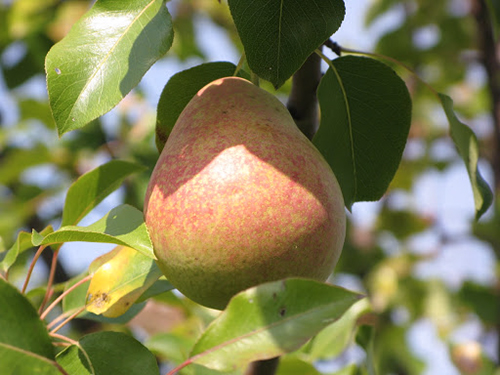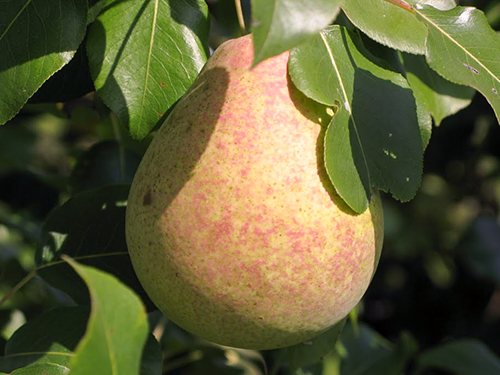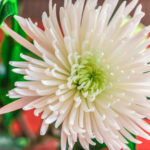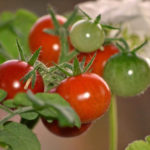Pear variety Marble
Marble - a pear variety with fruits of early autumn ripening, bred at the Rossoshansk zonal experimental gardening station through hybridization of 2 varieties - Bere Zimnyaya Michurina x Forest beauty... Authors of the pear: G. D. Neporozhny, A. M. Ulyanishchev. Since 1965, the variety has been zoned (included in the State Register) in the Central, Central Black Earth, Lower Volga and Volga-Vyatka regions. The variety was most widespread in the south of the Central Black Earth Region.

The trees have medium vigor and a wide pyramidal, medium thickened crown. The ability to shoot is weak. The branches are powerful, with an oblique-vertical arrangement. The bark on the trunk and main branches is greenish-gray. Ring-type fruiting: fruits are tied mainly on ringlets, located on young 2 - 4-year-old branches.
Shoots are directed upward and are colored reddish brown. Lentils are small in size, light in color, faintly noticeable and are common. Buds are triangular, protruding, brown in color. The leaves are medium in size, green in color, ovoid, without pubescence, with finely toothed edges and a rounded base, located at an acute angle to the shoot. The leaf blade has a smooth, glossy, almost even surface. Petioles are medium in length, uncolored.
Umbellate inflorescences, consist of a large number of flowers (each has an average of 8 - 9 pieces). The buds are white. The flowers are quite small in size (up to 3 cm in diameter), saucer-shaped, white in color, not terry. Petals with solid edges, slightly closed. The stigma of the pistils is at the same level as the anthers. Trees bloom earlier than other varieties.

The fruits of the Marble pear are of a higher average size, weighing an average of 150 - 180 g (rarely reaching 200 - 220 g). The shape of the fruit is correct, round-conical. The surface is leveled, smooth. The skin is rather thick, with small, rusty subcutaneous punctures. The main color is greenish-yellow, the integumentary color occupies most of the surface in the form of a marbled or blurred orange-red blush. The stalks are quite thick, medium in length. The funnel is expressed in the form of a slight depression. The saucer is small and wide. Half-open cup. Seeds of medium size, light brown color, are present in small quantities.
The pulp can be white or creamy, coarse-grained in structure, very good sweet taste, very juicy, tender, melting, aromatic. The assessment of appearance on a 5-point tasting scale is 4.7 points, taste is estimated at 4.8 points. By chemical composition, the fruits contain: dry matter (15.8%), the amount of sugars (10.8%), titratable acid (0.07%), ascorbic acid (7.3 mg / 100 g). By design, the variety belongs to the dessert type.
In the south of the Voronezh region, the period of removable fruit ripeness falls on the end of August - beginning of September. The consumer period usually lasts for 3 - 4 weeks, the maximum period is until mid-October. Pears are stored for no more than 60 - 70 days. Thanks to its strong skin, fresh fruits have a very high level of transportability. The commercial quality of the fruit is high.

Fruiting of pears Marble begins at 6 - 7 years after budding in a nursery. Productivity can range from medium to high, depending on the level of moisture supply (determined by natural precipitation, irrigation regime, depth of groundwater). Under the conditions of the Rossoshansk station, the average yield level at its various sites over the years of study was from 160 to 240 c / ha, the maximum yield is 420 c / ha. A significant factor that reduces the yield of this variety is the easy shedding of fruits with a lack of moisture (especially during dry periods) and in the absence of decent wind protection in trees.
The level of winter hardiness in the conditions of the Central region of Russia is borderline.So, in the southern part of the Central Black Earth region, the winter hardiness of the variety is sufficient, but in its northern part it is only at an average level. In 1976 and 1978, freezing ranged from 0.7 to 2.7 points (that is, at the level of Bessemyanka). In the conditions of spring frosts (May 6 - 7, 1999, when the temperature dropped to minus 6 ° C; May 2 - 20, 2000, at minus 2 ° C), by the end of flowering, there was a strong freezing of flowers (up to 100%). The cultivar's resistance to powdery mildew and scab is very high.
The main advantages of the Marble pear are: exceptional resistance to scab, high commercial and consumer qualities of the fruit.
And although the winter hardiness of the variety in the south of the Voronezh region is practically on a par with Bessemyanka, the level of yield and quality of fruits in Mramornaya is still much higher.
It is also worth noting that Marble is a valuable donor in breeding work when developing new varieties with high quality fruits.
The main disadvantages include an insufficiently high level of drought resistance, which entails high shedding of fruits and a decrease in yield; low winter hardiness of flower buds, low rate of early maturity, insufficiently high level of winter hardiness for the Central region.









Delicious dried fruits are obtained from this pear. Light and sweet like candy. The yield was high both in 2015 and in 2016 (the tree grows in a dacha 20 km from Minsk, Belarus). But half of the crop was lost from rust. Recently, rust has been a real scourge for any country pears.